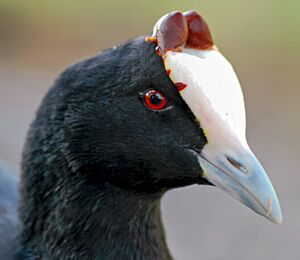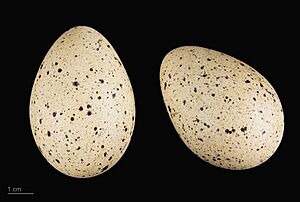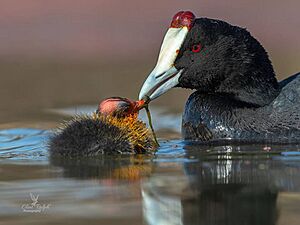Red-knobbed coot facts for kids
Quick facts for kids Red-knobbed coot |
|
|---|---|
 |
|
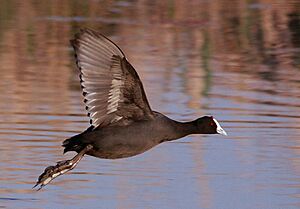 |
|
| Adult birds in South Africa | |
| Conservation status | |
| Scientific classification | |
| Genus: |
Fulica
|
| Species: |
cristata
|
The red-knobbed coot (also called the crested coot) is a type of bird that belongs to the rail and crake family, known as Rallidae. Its scientific name is Fulica cristata.
These birds live in many parts of Africa and in the very south of Spain. They prefer freshwater lakes and ponds. Red-knobbed coots build their nests from dead reeds. They often place their nests near the water's edge or floating on the water. A female coot usually lays about 7 eggs, but can lay more if conditions are good.
Contents
What's in a Name? (Taxonomy)
The red-knobbed coot was officially named in 1789 by a German scientist named Johann Friedrich Gmelin. He placed it in the genus Fulica, which is the group for all coots. He gave it the two-part scientific name Fulica cristata.
The word Fulica comes from a Latin word for a Eurasian coot. The second part, cristata, is also Latin and means "crested" or "plumed." This name refers to the small crests or knobs on the bird's head. This species is unique and does not have different types or subspecies.
What Does a Red-knobbed Coot Look Like?
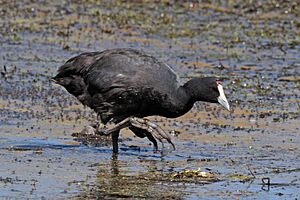
The red-knobbed coot is mostly black. It has a white patch on its forehead, called a frontal shield. These birds are about 35 to 42 centimeters (14 to 17 inches) long. Their wings can spread out to 75 to 85 centimeters (30 to 33 inches).
Male coots weigh about 770 to 910 grams (1.7 to 2 pounds). Females are a bit smaller, weighing 455 to 790 grams (1 to 1.7 pounds). Both male and female coots look very similar. Since they are good swimmers, they have special partial webbing on their long, strong toes.
Young coots are lighter in color than adult birds. They have a whitish chest and do not have the white facial shield yet. The black feathers of an adult coot grow in when the young bird is about 3 to 4 months old. However, the white facial shield takes longer to fully develop, usually around one year of age.
It can be tricky to tell the red-knobbed coot apart from the Eurasian coot. Their living areas overlap in parts of Africa and Spain. Here are some ways to tell them apart:
- The red-knobbed coot has two tiny red knobs on top of its facial shield. These are hard to see from far away and only appear during the breeding season.
- The black feathers between the white shield and the beak are rounded on a red-knobbed coot. On a Eurasian coot, this area comes to a point.
- The beak of a red-knobbed coot has a bluish-grey color.
- When flying, the red-knobbed coot does not have the white edge on its wing feathers that the Eurasian coot has.
How Do Red-knobbed Coots Behave?
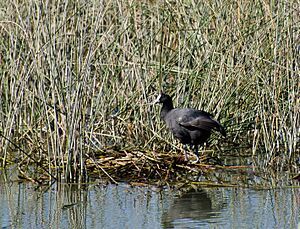
Red-knobbed coots act very much like Eurasian coots. They are not as shy as most other birds in the rail family. If they are not bothered, they can be quite bossy. They might even try to scare away larger birds, like Egyptian geese, if they feel their space is invaded.
You can often see them swimming on open water or walking on grassy areas near the water. They are very protective of their territory, especially when they are raising their young.
Red-knobbed coots do not like to fly much. When they do take off, they run across the water, splashing a lot. They also do this if they need to move quickly for a short distance, like escaping a rival or getting a tasty piece of food. When they swim, they bob their heads. They also make short dives by jumping a little first.
Reproduction and Life Cycle
The nest of a red-knobbed coot is a large platform made of reeds and plant stems. It is built in shallow water by both the male and female coot. The female lays 5 to 7 eggs, one egg each day.
Both parents take turns sitting on the eggs to keep them warm. This is called incubation. The eggs hatch after 18 to 25 days. The chicks do not all hatch at the same time. The fluffy chicks, called precocial chicks, leave the nest just one day after hatching. Both parents feed and care for the chicks for about 55 to 60 days.
What Do Red-knobbed Coots Eat?
Red-knobbed coots are omnivores, meaning they eat both plants and animals. They will eat small live prey, including the eggs of other water birds. However, their main food source is usually water plants, like different kinds of Potamogeton. They often dive underwater to find these plants.
These birds can be quite noisy, especially during mating season. Their calls are different from the Eurasian coot. They make a fast "kerrre" sound, a harsh "ka-haa," and a grunting "oot oot." The "oot oot" sound might make you think that's where the name "coot" comes from, but the word "coot" actually has a different origin!



